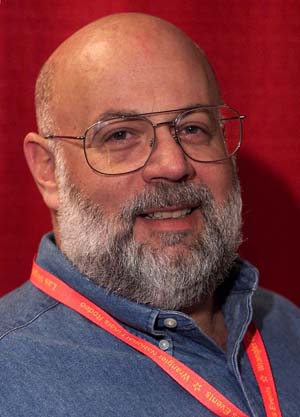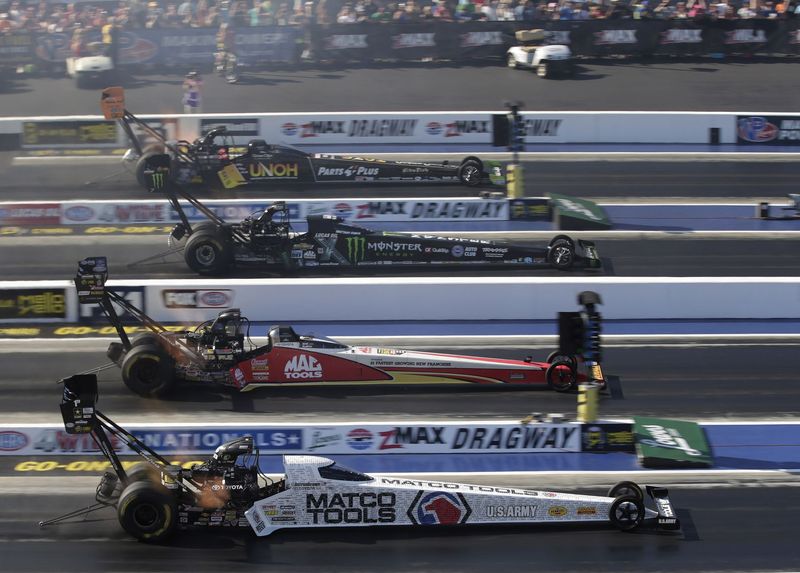STRAIGHT AHEAD WITH JEFF WOLF - FOUR-WIDE DRAG RACING IS AN ACQUIRED TASTE

When motorsports magnate Bruton Smith’s publicly held Speedway Motorsports Inc. purchased Las Vegas Motor Speedway in 1998, one of his first projects was to complete construction of the dragstrip where only a massive concrete grandstand stood near the big oval track upon the acquisition.
It was slated to be the first permanent four-lane dragstrip. But while most of the infrastructure was prepared for double-wide racing, only two lanes were completed in 1999. It remained that way until work began late last year to expand it to four lanes for competition and Las Vegas now has joined SMI’s sister track zMAX Dragway at Charlotte Motor Speedway as the only four-lane dragstrips in the world.
The 91-year-old Smith is founder and chief executive of Speedway Motorsports (SMI) and a stalwart in NASCAR’s world for five decades having created trendsetting and fan friendly venues from coast to coast.
He followed suit with innovative drag racing facilities that are the standard bearers for stadium excellence on the NHRA Mello Yello Drag Racing Series circuit that visits 21 tracks annually.
SMI currently hosts six of 24 Mello Yello Series events – 25 percent – including two events each at Las Vegas and Charlotte with one at Bristol, Tennessee, and Sonoma Raceway in Northern California.
Drag racing fans seem eager to experience the inaugural April 6-8 DENSO Spark Plugs NHRA Nationals, the fourth event of this year’s NHRA Mello Yello Series season, at the recently widened The Strip at Las Vegas Motor Speedway.
It’s a sensory overload experience to savor, but the concept hasn’t evolved without controversy.
Three days after the inaugural Four-Wide event in March 2010, the Professional Racers Owners Organization (PRO), which continues as the pro categories’ lobbying body to NHRA, sent a letter to then NHRA president Tom Compton notifying him that its members would no longer compete in the four-wide format if championship points were on the line

· Entire racing surface of old track was removed and only the left guardwall remained
· Finish-line underground tunnel extended 64 feet
· 10,000 tons of gravel
· More than 225,000 pounds of steel rebar
· 10,000 feet of fiber optic cable for timing system
· 8,000 tons of asphalt
· 4,400 cubic yards of concrete
Courtesy of Las Vegas Motor Speedway
DID YOU KNOW?
When original owners and builders of LVMS, the late Ralph Engelstad and Richie Clyne, began building the sprawling LVMS facility, they relied on someone who knew a little about drag racing to determine the direction and grade of the dragstrip.
That person was the late Wally Parks, who Powell said is the person who convinced Smith to finish the dragstrip.
Parks was 94 when he died in 2007, and was at The Strip when it opened 2000.
The main entrance into The Strip was renamed Wally Parks Way in 2003.
NHRA team owners expressed concern over safety and said that the format is confusing for competitors and fans and that the wide-angle need for televised coverage that was necessary to show all four cars reduced the visibility of sponsors’ branding on race cars.
After saluting Smith in the letter for providing “top-notch facilities to the sport … (and acknowledging) his efforts to increase awareness and visibility for our sport by holding a one-of-a-kind, four-wide drag racing event,” a survey of participating teams led the PRO Board of Directors to state its members “will not participate in a four-wide national event involving points again.”
The vote was 60-3 giving a thumbs-down to four-wide racing for points.
But what Smith wants from NHRA, Smith gets. And he probably should be rewarded for his multimillion-dollar commitment to NHRA.
Modifications have transpired over the past eight four-wide races to remedy most initial concerns about safety, simplifying staging procedures for drivers and making it as easy as possible for fans to understand the finishing order for each quad during eliminations.
The Four-Wide near Charlotte has drawn big crowds, especially on Saturdays, and Las Vegas expects a major improvement for attendance over recent Spring events that have always paled to the penultimate Mello Yello event there in the Fall.
“The excitement surrounding our inaugural four-wide drag race has been phenomenal,” said LVMS president Chris Powell, who has run the facility since SMI purchased it.
“We’re expecting one of the largest crowds we’ve ever had for an NHRA national event, and everyone from fans to competitors has been talking about this race for months. This has become one of the most anticipated first-time events in our speedway’s history.”
And racing four-wide was not Smith’s original intent for building a pair of two-lane tracks separated by a concrete guardwall near Charlotte.
Smith was dismayed when an oil-down or engine explosion would shut down racing for clean-up so his plan was if one pair needed extended clean-up that racing would immediately switch to the other pair. That vision would seem to have merit.
NHRA executives didn’t want cars running at 300 mph only a few dozen feet or so from its Safety Safari crew so the time-saving concept was quashed. After a couple exhibition four-wides, the event became a full-fledged Mello Yello points event.
So if NASCAR’S premier Cup series could have only two-road races on its annual schedule then NHRA could have a pair of four-wides on its calendar.
There is nothing in racing to match the extreme nature of a Four-Wide, and shorter race days might not be that bad for casual fans.






































